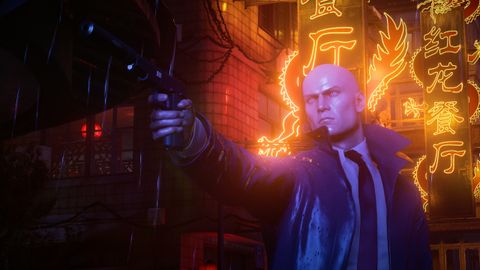Our Verdict
A beautiful, deep, and endlessly replayable murder sandbox, featuring some of the best levels in the series.
PC Gamer's got your back
What is it? A globe-trotting assassination simulator.
Expect to pay £50/$60
Developer IO Interactive
Publisher In-house
Reviewed on RTX 2080 Super, Intel i7-9700K, 16GB RAM
Multiplayer None
Link Official site
And so we've come to the end of IO Interactive's so-called World of Assassination trilogy, which began with the Danish developer's first Hitman reboot back in 2016. These are some of the best systems-driven stealth games on PC, and Hitman 3 tops the series off with a superb collection of levels—some of which are among the best in the entire Hitman series. This is a spiritual and mechanical continuation of the previous two games, but IO still has a few surprises up its sleeve. And one level in particular might just be the studio's masterpiece.
I'm in an abandoned warehouse on the outskirts of Berlin. Spindly lasers and spotlights sweep across a shadowy dancefloor, revealing a sea of bobbing heads hypnotised by throbbing techno music. The music is so loud, and the bass so deep, it makes my headphones vibrate. But I'm not here because Agent 47 has given up contract killing and joined the German rave scene, even though that would be a pretty funny way to end the story. I'm here to murder a team of deadly assassins who are also trying to murder me.

Ten hitmen are patrolling the warehouse and a scrubby industrial wasteland surrounding it. And here's the kicker: they know what I look like, even if I'm wearing a disguise. I can still change clothes to stroll past lowly security guards, but these trained killers aren't so easily fooled. If they catch sight of me they'll open fire, which means I have to rely on those swarms of pill-popping ravers, and the maze-like architecture of the building, to conceal myself.
Most Hitman targets are cowards hidden away in a fortress behind a wall of armed guards, which makes these guys so thrilling to go up against. It's a totally different dynamic, and one of the challenging missions in the trilogy as a result. There aren't even any Mission Stories in this level, the in-game hint system that usually suggests entertaining ways to kill your targets. This encourages you to experiment with the sandbox and dream up your own methods.
Now all I have to do is figure out how to kill them without anyone noticing, in front of thousands of witnesses, in the middle of a rave
To complicate matters, the assassins are also disguised. To identify them I have to steal an earpiece and listen in on their conversations. When I catch one talking to their handler in instinct mode—which highlights targets, points of interest, weapons, and so on—their cover is blown and they're marked permanently on the map. Now all I have to do is figure out how to kill them without anyone noticing, in front of thousands of witnesses, in the middle of a rave. I could just shoot them and run away, of course, but that's no way to play Hitman.
It seems impossible at first. Some of the targets follow routines where they're constantly surrounded by people. One of them, the leader, even has a bodyguard who never leaves his side. But the beauty of Hitman is carefully studying these big, intricate levels, making a mental map, and finding holes in the security to exploit. When you do finally manage to kill five of these assassins—enough to send the others fleeing—it feels incredible.
Although Hitman 3 builds on the solid foundations laid by the first two parts of the trilogy, sharing the same AI, stealth systems, and user interface, IO has also taken this opportunity to experiment a little with its tried and tested formula. The complex, open-ended Berlin level is the most the studio has ever trusted a Hitman player to take the lead and figure things out for themselves. And in the other levels there are, surprisingly, only three Mission Stories per map, compared to an average of about ten in the previous two games' levels.
The opportunities are still there: elaborate traps to set up, people to pose as, shortcuts to take, keys to swipe. They just aren't as clearly signposted this time around, forcing you to engage more with the environment around you. At its core this is still very much a classic Hitman game, but in many ways a more playful, experimental one. One level set in a dusty old mansion in Dartmoor, England sees Agent 47 posing as a private detective and solving a murder mystery straight out of an Agatha Christie novel. It's a gimmick, but a fun, unique spin on what is otherwise a fairly typical assassination mission.
The mansion itself is brilliantly constructed. Long, dark corridors lined with oil paintings open up into bright, lavishly decorated drawing rooms. And behind the walls there's a labyrinth of secret passages to discover with peepholes for spying on people. There's also a wonderful feeling of isolation, with the house standing alone in an expanse of barren, overcast moorland that stretches infinitely into the distance. No one makes places quite like IO Interactive, and in Hitman 3 you'll find some of the developer's finest creations to date.

Chongqing is another standout. It's a pretty straightforward mission compared to Berlin and Dartmoor, but an incredible piece of level design. Above, rain-soaked streets buzzing with fluorescent neon signs, noodle bars, apartment blocks, and winding, trash-stuffed alleyways. Below, a gleaming futuristic facility with multiple layers of security, heavily armed guards, and vent systems to slip through. This impossibly intricate double-stacked level is one of the most impressive things IO has ever created; both in terms of atmosphere and aesthetic, and in how many interesting ways there are to navigate it.
As for the other levels, Hitman 3 opens with Agent 47 taking a trip to Dubai and infiltrating a glamorous soirée at the top of its tallest building. He enters the level by parachute, crawls through a window, slips into a tuxedo, and blends into the crowd—as if we needed any more proof that IO loves James Bond. It's a real visual treat too, with immense gilded palm trees, reflecting pools, and dramatic views over the cloud-covered city. But for all its glamour it's a rather simple, reserved level, feeling more like a tutorial to ease new players in.
This impossibly intricate double-stacked level is one of the most impressive things IO has ever created
Dubai introduces the digital camera, a largely forgettable new gadget that 47 always has in his inventory, regardless of what you selected at the mission planning phase. With it you can scan things for extra intel or hack electronic panels to trigger certain things—for instance, activating a futuristic window's frosted glass to cover you, or remotely opening a vent cover. It's a frivolous addition, really, and feels slightly out of place in a Hitman game. But the levels are almost never designed around it, so thankfully it's not too intrusive. And in its favour, I do like how you can use the zoom function to scout ahead.
Later, 47 travels to Mendoza, Argentina and sneaks into yet another high-class party: this time at a winery. With golden early evening sun falling over the vineyards, it's gorgeous to look at, and a Mission Story involving a sniper is especially devilish. The level is split between the winery, where the party is being held, a scattering of rocky foothills patrolled by gaucho guards, and a colonial villa where one of your targets lives. It's another level that plays things relatively safe, but it's much more detailed and involved than Dubai.

The sixth and final map, set among Romania's rugged Carpathian Mountains, isn't a typical Hitman level at all. It's more like an action set-piece, designed to finish Agent 47's story in spectacular fashion. It's a tightly choreographed, visually impressive finale, but it is, essentially, scripted. Without spoiling anything, the nature of the level means there's no room for exploration. You do get a few opportunities to flex your creativity, but mostly you're just doing what you're told. This makes it the weakest by default, even though it's crafted with the same level of care and polish that defines all of IO's levels.
Over the years, IO has gotten really good at designing the many small stealth challenges that litter its levels. The placement of guards, improvised weapons, blind corners, security cameras, and places to hide bodies is often pitch perfect. There are countless tiny, satisfying moments in these levels where you're given just enough to cleverly outfox the AI and use the environment to your advantage. You rarely feel backed into a corner, or in a situation you can't find a way out of, which speaks to the quality of the game's design. And as you unlock additional tools and gadgets, the sandbox only gets deeper and more varied.
Despite a couple of weaker levels, Hitman 3 is a sensational stealth game. Berlin, Chongqing, and Dartmoor represent the series at its best, which is a fine way to end the trilogy. And if you own the first two games you can—once Epic figures out how—access all of those levels here, with improved visuals and the ability to use the new game's gadgets and weapons in them. Do that, and this is easily one of the best games on PC. If this was a review of the trilogy as a whole, I'd stick a couple more points on the review score. But even on its own, Hitman 3 is a magnificent videogame and a perfect swansong for Agent 47.
A beautiful, deep, and endlessly replayable murder sandbox, featuring some of the best levels in the series.
If it’s set in space, Andy will probably write about it. He loves sci-fi, adventure games, taking screenshots, Twin Peaks, weird sims, Alien: Isolation, and anything with a good story.

VR gaming was one of my favourite hobbies of 2024 and it's because I've noticed myself using it as a meditation exercise

Helldivers 2 galactic war timeline: Every major event that's happened so far

2024 was the year I returned to earbuds after writing them off for nearly a decade thanks to the SteelSeries Arctis GameBuds
